Political graphics of
the “long 1960s”
by Lincoln Cushing
Essay published in New
World Coming : The Sixties and the Shaping of Global Consciousness,
2009,
edited by Karen Dubinsky, Catherine Krull, Susan Lord, Sean Mills and
Scott Rutherford,
Between The
Lines press.
Introduction
Posters are among the significant ephemera of the long 1960s. Synonymous with rebellion and visual wit, these fragile documents were densely packed cultural viruses capable of transmitting such abstract concepts as “solidarity,” “sisterhood,” or “peace” all over the world.
Political posters did not blossom as a cultural form until the mid-1960s. In the United States, the chilling effect of the Cold War and McCarthyism during the 1950s made it too dangerous to produce political content for public spaces. The socially-conscious graphic artists had turned inwards, continuing to create limited-edition prints shared among friend and displayed in shows, and only occasionally did something agitational make it to the streets. The Civil Rights Movement imagery was limited to a few placards, such as the iconic “I AM A MAN” placard – characterized by use of simple type and without illustration. The Free Speech Movement, vibrant though it was with song, poetry, and theater, did not produce a single poster. It was not until the rock and counterculture posters exploded on the scene in the San Francisco Bay Area that public appetite for these visual expressions spread to political posters. Similarly, the visually radical new imagery from the Cuban film institute ICAIC inspired the other Cuban political publishing agencies to push their own design work in new directions.
Although these documents were often produced in the thousands, social neglect and physical impermanence have reduced their numbers to a ghost. Huge voids in scholarship remain to be filled. A handful of community-based archives and special collections – most notably among them the Center for the Study of Political Graphics in Los Angeles and Michael Rossman’s AOUON Archive in Berkeley – have taken on the huge task of drawing these artifacts out of the woodwork, arranging them, cataloging them, and making them accessible to scholars and the public.
The following series of images, in chronological order, are a sampling of this enormous genre.
Lincoln Cushing
Docs Populi
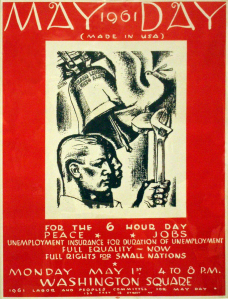
1. “May Day 1961”
Publisher: 1961 Labor and Peoples Committee for May Day
Artist: Hugo Gellert
Year: 1961
With the Liberty Bell and subtitle “Made in USA” in parentheses, this poster telegraphs the struggle for public legitimacy sought by the Communist Party, U.S.A. at the end of the 1950s. The organizing committee was forced to host this hallmark radical memorial in New York’s Washington Square instead of the preferred Union Square because they were denied a permit, and were also refused use of loudspeakers because they might interfere with classes at nearby New York University. Though beautifully hand-lettered and illustrated by lifelong activist illustrator Hugo Gellert, the simple two-color poster nonetheless remains locked in a design aesthetic little changed from the W.P.A. posters of the 1930s.
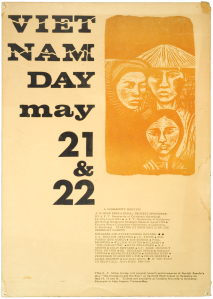
2. “Viet Nam Day : May 21 & 22”
Artist: unknown
Publisher: [Viet Nam Day Organizing Committee]
Year: 1965
Although broadly similar in
general design to Gellert’s 1961 May Day poster – both illustrated
two-color announcements – this early antiwar movement piece displays
characteristics of many New Left outreach documents. Likely designed
and produced by an amateur, it is composed of a main title created with
hand-applied commercial transfer lettering that has been artistically
“cracked” to highlight the crisis of the situation. The smaller text
was produced on a typewriter; Jerry Rubin’s home phone number was
listed as the contact. The illustration carries no artist’s name,
typical for a creation ethic that considered personal credit for
political antithetical to the collective values of the movement.
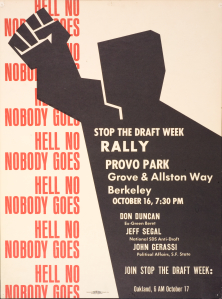
3. “Stop the Draft Week”
Artist: Frank
Cieciorka
Publisher: [Stop the Draft Week Organizing Committee]
Year: 1967
Stop the Draft Week was a nationwide antiwar initiative, and the demonstration at the Oakland Induction Center was the largest yet held against U.S. involvement in Vietnam. The popular anti-draft slogan “Hell no, I won’t go” had been deliberately expanded to reflect the “we” collectivity of the resistance. Massive presence by police almost guaranteed that this demonstration would escalate into a riot, and involved the beating of hundreds and several arrests. A subsequent set of rallies in January of 1968 for the defense of the “Oakland Seven” resulted in a poster with the stylized clenched fist clipped off, highlighted as the only graphic element – giving birth to the iconic “New Left fist” later adapted by Students for a Democratic Society and many other groups.
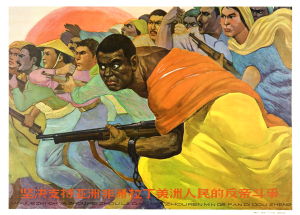
4. “Resolutely support the anti-imperialist struggle of
the Asian, African and Latin American people.”
Artist: Zhou Ruizhuang
Publisher: Shanghai People's Fine Art Publishing House
Year: 1967
China’s Great Proletarian Cultural Revolution (1966-1976) has been called "the largest social engineering effort in the history of mankind." Posters generated during this period were defined by several guiding political principles, among them avoidance of Western and classical Chinese styles, support for artwork from previously disenfranchised social strata and regions, and rejection of “art for art’s sake.” Although most of the posters were intended for a Chinese audience, many were broadly distributed around the world and sold through solidarity bookstores and political groups. The iconographic and textual messages they expressed were issues that resonated with activists across the world working on issues such as women’s rights, international solidarity, and anti-imperialism.
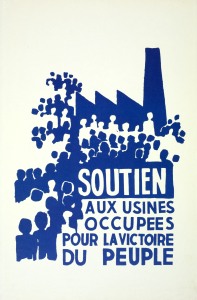
5. “Soutien aux usines occupies pour la victoire du
people”
(“Support the factory occupations for a peoples’ victory”)
Publisher: Atelier Populaire No. 1 (École Nationale Supérieure des
Beaux-Arts)
Artist: unknown
Year: 1968
In May 1968, Paris was gripped by a general strike that paralyzed the city. Students at six colleges joined in to produce a massive outpouring of silkscreen posters expressing the spirit of the strike in more than 600 distinct designs - challenging the police, the DeGaulle government, and the nature of bourgeois society itself. The two most prolific ateliers (workshops) were the École Nationale Supérieure des Beaux-Arts and the École Nationale Supérieure des Arts-Décoratifs. The creative flood of these graphic works stands as a milestone in the history of revolutionary art. The students adopted a medium that was unfamiliar to them – screen printing – because it was cheap, fast, and could be done with available supplies and volunteer labor. The pressure to generate numerous titles over a short period was accomplished by a design aesthetic of relatively simple, monochromatic images that nonetheless succinctly captured the spirit of the moment.
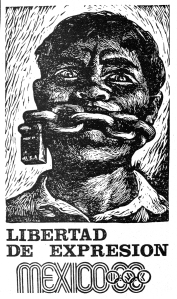
6. “Libertad de expresión”
Artist: Adolfo Mexiac
Publisher: Taller de Gráfica Popular (Mexico)
Year: 1968
One of the most dramatic posters to come out of the Mexican student movement was this image of a gagged citizen. Ten days before the opening day of the 1968 Summer Olympics in Mexico City, hundreds of students had been killed by army troops in the Plaza de las Tres Culturas in Tlatelolco while protesting the military occupation of the National Polytechnic Institute. This poster was printed by Mexico’s preeminent political graphics workshop, the Taller de Gráfica Popular (TGP) founded in 1938.
The graphic was “recycled” from an earlier TGP election handbill from 1958, with the addition of “Made in USA” on the padlock. According to TGP artist Alberto Beltrán in conversation with Carol Wells of the Center for the Study of Political Graphics, the 1958 version was itself originally from an even earlier version done in 1954 when a CIA-supported military junta overthrew the democratic Guatemalan government of Jacobo Arbenz.

7. “Day of solidarity with Zimbabwe”
Artist: Faustino Pérez
Publisher: Organization in Solidarity with the People of Africa, Asia
and Latin America (OSPAAAL)
Year: 1970
OSPAAAL is a
Non-Governmental Organization recognized by the United Nations, based
in Havana, Cuba, with a board of representatives from all over the
world. It is the primary producer of international solidarity posters
in Cuba. Among its many activities has been the publication of Tricontinental
magazine since 1967. At its peak its circulation was 30,000 copies,
produced in four different languages and mailed to 87 countries.
Included in most issues were folded-up solidarity posters, thus
establishing the most effective international poster distribution
system in the world. Cuban artists were particularly adept at
expressing abstract concepts in succinct visual form; this poster
elegantly represents the triumph of indigenous resistance to
colonialism.
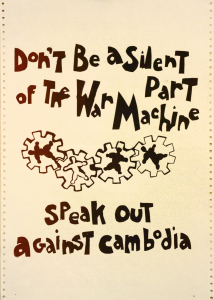
8. “Don’t be a silent part of the War Machine : Speak out
against Cambodia”
Publisher: [U.C. Berkeley student poster workshop]
Artist: unknown
Year: 1970
After the antiwar student demonstrations and killings at Kent State, Ohio (May 4, 1970) and Jackson State, Mississippi (May 14, 1970) there was a massive upswelling of resistance culture in the United States. Political poster workshops blossomed all over the country (including the California College of Arts and Crafts in Oakland, the University of Southern California's School of Architecture, and the Poster Factory in Minneapolis) to express public outrage. At the University of California, Berkeley faculty at the College of Environmental Design encouraged the use of campus facilities for a short-lived workshop that created an estimated 50,000 copies of hundreds of works. Although most of these were about the war, numerous other issues of the day were examined – such as the role of higher education under capitalism, student self-determination, police violence, and the Nixon presidency. Many of these exhibit the same design characteristics as those of Paris 1968, and were clearly influenced by that body of work. This example is on discarded tractor-feed computer paper.
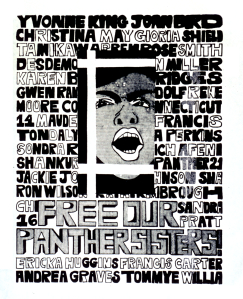
9. “Free our Panther sisters”
Publisher: [unknown]
Artist: unknown
Year: circa 1970-1971
Although the best-known posters of the Black Panther Party were illustrations by Minister of Culture Emory Douglas or the iconic photo of an armed Huey Newton in a wicker chair, many other images were produced concerning the wide range of issues surrounding the Party. This one addressed efforts to liberate incarcerated Panthers – seen as political prisoners in proto-fascist America – as well as the struggle for recognition of the contribution of women in the movement. The Panther 21 were arrested April 2, 1969 and charged with conspiracy to plant bombs at several New York public sites. On May 13, 1971, after the longest political trial in New York's history, they were acquitted of all charges after less than an hour of jury deliberation. In the case of the Connecticut 14, also known as the New Haven 14, Panthers were charged with the murder of an alleged police informant, but were eventually acquitted in what proved to be charges based on COINTELPRO malfeasance.
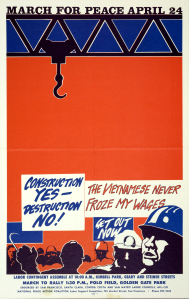
10. “March for Peace April 24”
Artist; unknown
Publisher: National Peace Action Coalition, Labor Support Committee
Year: 1971
During the 1950s, having purged most of the leftwing critics of U.S. foreign policy, organized labor had benefited greatly from the cold war economy and was almost universally supportive of U.S. government military actions. As historian Philip Foner noted, “Labor spoke with a Neanderthal voice. In May of 1965, George Meany declared that the AFL-CIO would support the war in Vietnam ‘no matter what the academic do-gooders may say, no matter what the apostles of appeasement may say.’ ” But as the war ground on, and working-class soldiers come home in body bags, support began to crumble and labor began to change. First, independent locals spoke up, and in 1969 the Alameda County Central Labor Council (CLC) came out against the war, the first CLC in the country to do so. The following year trade unionists ran full-page ads in the WashingtonPost and the San Francisco Chronicle against the war. The April 24 demonstration in San Francisco, even though not endorsed by the CLC, was a groundbreaking show of antiwar solidarity by major trade unions. [More labor posters]
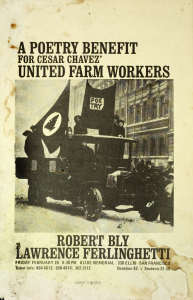
11. “A poetry benefit for Cesar Chavez’ United Farm
Workers”
Artist: unknown
Publisher: [unidentified United Farm Workers support group]
Year: 1971
The grassroots organizing and boycott campaigns of the United Farm Workers deliberately and dramatically involved the massive participation of community organizations. This poster, a benefit by popular poets at a well-known progressive San Francisco church, displays a vigor and whimsy that was not typical of the rest of organized labor. By the mid-1960s beat poetry had moved beyond the confines of cafes and bars, and this reading reflects a convergence of the counter-culture and the activist migrant labor community. The source image – complete with snow and fur hats - was whimsically modified from a 1917 Bolshivek Revolution photograph.
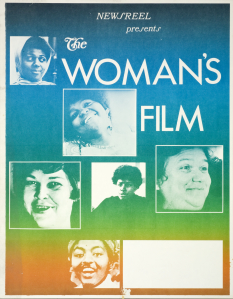
12. “Newsreel presents The Woman’s Film”
Publisher: San Francisco Newsreel
Artist: unknown
Year: 1971
Efforts to develop alternative media – tools to document, analyze, and disseminate the issues not covered critically or at all by the mainstream channels – were an integral part of the New Left. This poster publicizes a woman-made film from San Francisco Newsreel, a west coast office and distribution center amplifying the work of the original Newsreel founded in New York in 1967. Additional Newsreel offices were active in Detroit, Boston, Kansas, Los Angeles, Vermont, and Atlanta. After many internal political struggles over the years, the work continues; there is a Third World Newsreel in New York, and a California Newsreel in San Francisco. The Vermont Newsreel Archives maintains their historical records and footage. This film was a collective effort involving the women behind the camera as well as those being documented, a deliberate effort to challenge conventional artist-subject roles.
Also see:
"Up Against the Wall: Berkeley Political Posters from the 1960s" exhibition
at Berkeley Historical Society 2009
"Anti-Nazism and the Ateliers Populaires: The Memory of Nazi
Collaboration in the Posters of Mai ’68," essay
by Gene-Marie Tempest
Image sources
All posters digitized by author
except for #1, provided by host archive.
1. Special Collections Research
Center, Syracuse University Library.
2. Michael Rossman AOUON Archive,
Berkeley, CA.
3. Lincoln Cushing Archive (gift of Ann Tompkins), Berkeley, CA.
4. Ann Tompkins (Tang Fandi) and Lincoln Cushing Chinese Poster
Collection, East Asian Library, U.C. Berkeley.
5. Holt Labor Library, San Francisco.
6. Center for the Study of Political Graphics, Los Angeles, CA.
7. Lincoln Cushing Archive, Berkeley, CA.
8. Michael Rossman AOUON Archive, Berkeley, CA.
9. H.K. Yuen Archive (item not yet accessioned, bulk of collection
at U.C. Berkeley).
10. Holt Labor Library, San Francisco.
11. Michael Rossman AOUON Archive, Berkeley, CA.
12. Lincoln Cushing Archive (gift of Ann Tompkins), Berkeley, CA.
Return to Docs Populi - Documents
for the Public
updated 4/23/2021